

Kufi. A kufi or kufi cap is a brimless, short, and rounded cap worn by men in many populations in Western Africa and Asia.
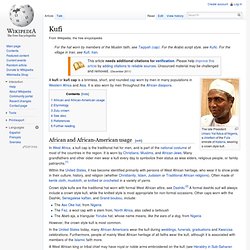
It is also worn by men throughout the African diaspora. African and African-American usage[edit] In West Africa, a kufi cap is the traditional hat for men, and is part of the national costume of most of the countries in the region. Kofia (hat) A traditional Kofia.
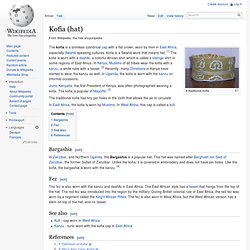
The kofia is a brimless cylindrical cap with a flat crown, worn by men in East Africa, especially Swahili-speaking cultures. Kofia is a Swahili word that means hat. [1] The kofia is worn with a dashiki, a colorful African shirt which is called a kitenge shirt in some regions of East Africa. In Kenya, Muslims of all tribes wear the kofia with a kanzu, a white robe with a tassel. [2] Recently, many Christians in Kenya have started to wear the kanzu as well. Songkok/Peci. The songkok or peci or kopiah is a cap widely worn in Indonesia, Brunei, Malaysia, Singapore, the southern Philippines and southern Thailand, mostly among Muslim males.
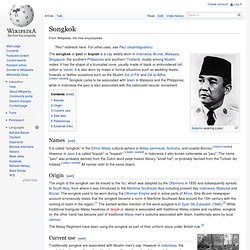
It has the shape of a truncated cone, usually made of black or embroidered felt, cotton or velvet. It is also worn by males in formal situations such as wedding feasts, funerals or festive occasions such as the Muslim Eid ul-Fitr and Eid al-Adha. [citation needed] Songkok came to be associated with Islam in Malaysia and the Philippines, while in Indonesia the peci is also associated with the nationalist secular movement. Names[edit] Taqiyah (cap) Shtreimel. Hasidic Jew wearing a shtreimel (fur hat), Jerusalem A shtreimel (Yiddish: שטרײַמל, pl.
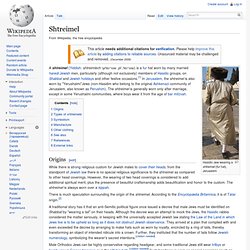
שטרײַמלעך shtreimlech) is a fur hat worn by many married haredi Jewish men, particularly (although not exclusively) members of Hasidic groups, on Shabbat and Jewish holidays and other festive occasions.[1] In Jerusalem, the shtreimel is also worn by "Yerushalmi"Jews (non-Hasidim who belong to the original Ashkenazi community of Jerusalem, also known as Perushim). Kolpik. A kolpik is a type of traditional headgear worn in families of some Chassidic rebbes (Hasidic rabbis), by unmarried children on Shabbat, and by some rebbes on special occasions which are not Shabbat or major holidays.
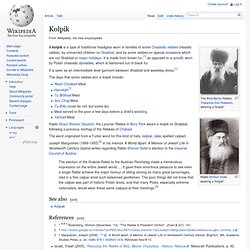
It is made from brown fur,[1] as opposed to a spodik, worn by Polish chassidic dynasties, which is fashioned out of black fur. It is seen as an intermediate level garment between Shabbat and weekday dress.[1] The days that some rebbes don a kolpik include: Rabbi Shaul Shimon Deutsch, the Lyozner Rebbe in Boro Park wears a kolpik on Shabbat, following a previous minhag of the Rebbes of Chabad. Kippah. A kippah, kippa or kipa (/kɪˈpɑː/ ki-PAH; Hebrew: כִּפָּה or כִּיפָּה; plural: kippot כִּפוֹת or כִּיפּוֹת), also known as a yarmulke ( i/ˈjɑrməlkə/ YAR-məl-kə or /ˈjɑːməkə/ YAH-mə-kə from Yiddish: יאַרמולקע, from the Aramaic meaning "fear of the King" (i.e.
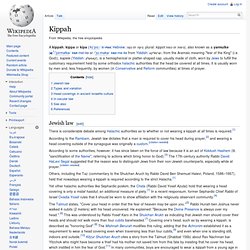
God)), kapele (Yiddish: קאפעלע), is a hemispherical or platter-shaped cap, usually made of cloth, worn by Jews to fulfill the customary requirement held by some orthodox halachic authorities that the head be covered at all times. It is usually worn by men and, less frequently, by women (in Conservative and Reform communities) at times of prayer. Jewish law[edit] There is considerable debate among Halachic authorities as to whether or not wearing a kippah at all times is required.[1]
Ushanka. Ushankas provide warmth to the wearer in the winter.
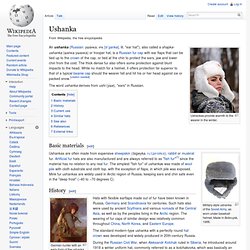
The word ushanka derives from ushi (у́ши), "ears" in Russian. Basic materials[edit] Military-style ushanka of the Soviet Army, as worn under baseball helmet. Made in Bobruysk, 1988. History[edit] Bearskin. A bearskin is a tall fur cap, usually worn as part of a ceremonial military uniform.

Traditionally, the bearskin was the headgear of grenadiers, and it is still worn by grenadier and guards regiments in various armies. Origins[edit] The cloth caps worn by the original grenadiers in European armies during the 17th century were frequently trimmed with fur. The practice fell into disuse until the second half of the eighteenth century when grenadiers in the British, Spanish and French armies began wearing high fur hats with cloth tops and, sometimes, ornamental front plates. The purpose appears to have been to add to the apparent height and impressive appearance of these troops both on the parade ground and the battlefield.[1] During the nineteenth century, the expense of bearskin caps and difficulty of maintaining them in good condition on active service led to this form of headdress becoming generally limited to guardsmen, bands or other units having a ceremonial role. Belgian Army[edit] Coonskin cap. Coonskin cap A coonskin cap is a hat fashioned from the skin and fur of a raccoon.
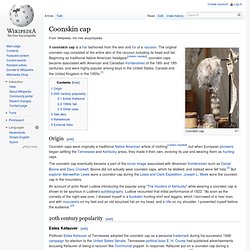
The original coonskin cap consisted of the entire skin of the raccoon including its head and tail. Beginning as traditional Native American headgear[citation needed], coonskin caps became associated with American and Canadian frontiersmen of the 18th and 19th centuries, and were highly popular among boys in the United States, Canada and the United Kingdom in the 1950s.[1] Origin[edit] Coonskin caps were originally a traditional Native American article of clothing[citation needed], but when European pioneers began settling the Tennessee and Kentucky areas, they made it their own, evolving its use and wearing them as hunting caps.
The coonskin cap eventually became a part of the iconic image associated with American frontiersmen such as Daniel Boone and Davy Crockett. 20th century popularity[edit] Newsboy cap. Eight-paneled caps in various colors.
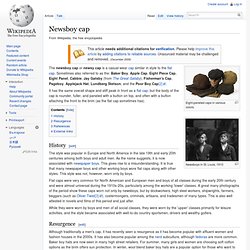
Newsboys in St. Ascot cap. The Ascot cap, also known as the Cuffley cap or Lippincott cap, is a hard men's cap similar to the flat cap, but distinguished by its hardness and rounded shape. Ascot caps are typically made from felt or wool and worn in the fall or winter, but straw Ascots also exist for warmer weather. An Ascot being of a single color mostly matches up with casual clothes of that color or those who match it with a suit match up the color with the suit setup. Unlike the flat cap, the inside is not lined with silk but the closed in design and softness of felt still provides comfort and warmth. The style dates back to 1900 and is popular as an Original. Student cap. A collection of various models in 1943 (from left to right: Danish, Norwegian and Swedish). In various European countries, student caps of different types are, or have been, worn either as a marker of a common identity, as is the case in the Nordic countries, or to identify the wearer as a member of a smaller body within the larger group of students, as is the case with the caps worn by members of German Studentenverbindungen.
Sweden[edit] A large crowd, mostly students in typical Swedish white student caps, participating in the traditional Walpurgis Night celebration with song outside the Castle in Uppsala. Cricket cap. A cricket cap is a type of soft cap, often made from felt that is a traditional form of headwear for players of the game of cricket, regardless of age or gender. It is usually a tight-fitting skullcap, usually made of six or eight sections, with a small crescent shaped brim that points downwards over the brow to provide shade for the eyes.
It is often, but not always, elasticised at the rear to hold it in place upon the wearer's head. Caubeen. A British army caubeen with a cap badge and green hackle Royal Irish Rangers uniforms The caubeen /kɔːˈbiːn/ is an Irish beret,[1] formerly worn by peasants.[2][3] It has been adopted as the head dress of Irish regiments of the British and Commonwealth armies. Name[edit] The name "caubeen" dates from late 18th century Irish, and literally means "old hat".[1] It is derived from the Irish word cáibín, meaning "little cape", which itself is a diminutive form of cába, meaning "cape".[1] Balmoral bonnet. Design[edit] Originally with a voluminous crown, today the bonnet is smaller, made of finer cloth, and tends to be dark blue, black, or lovat green.
Ribbons in, or attached to the back of, the band (originally used to secure the bonnet tightly) are sometimes worn hanging from the back of the cap. Glengarry. Tam o' Shanter (cap) Boater. Panama hat. Straw Porkpie Hat. Keffiyeh. Balaclava (clothing) Deely bobber. A woman wearing a deely bobber Origin[edit] Variants[edit] Deely bobbers remain a common party favor; for example, all the revelers on a pub crawl may wear similar deely bobbers. Similar headband-based novelties include Playboy-style bunny ears at bachelorette parties, or reindeer antlers at Christmas parties. References[edit] ^ Jump up to: a b c "Hard-Times Baubles". Conical Asian hat. Rice farmer in northern Cambodia wearing a Vietnamese-style conical hat In Asia and Australia[edit] Gat (hat) Bowler hat. Peaked cap. Side cap. Kepi. Shako. Custodian helmet. Bicorne. Tricorne. Patrol cap. Fedora.
Homburg (hat) True-Religion-Plaid-Trilby-Hat.